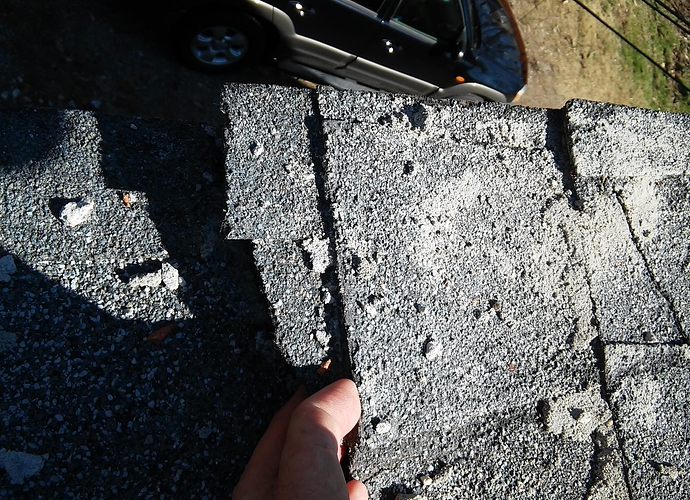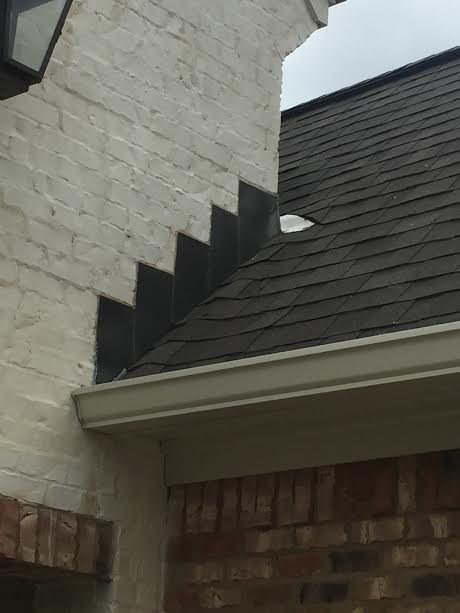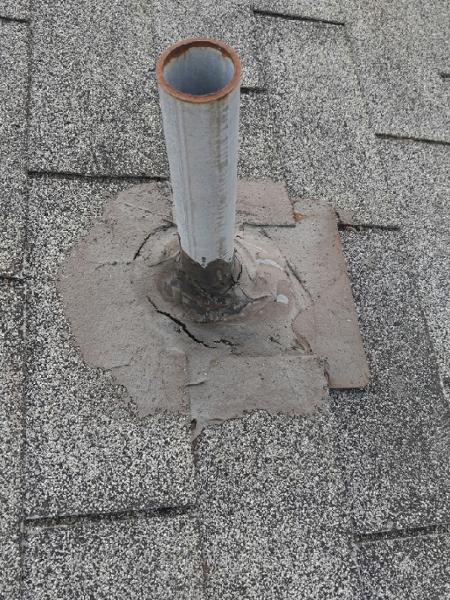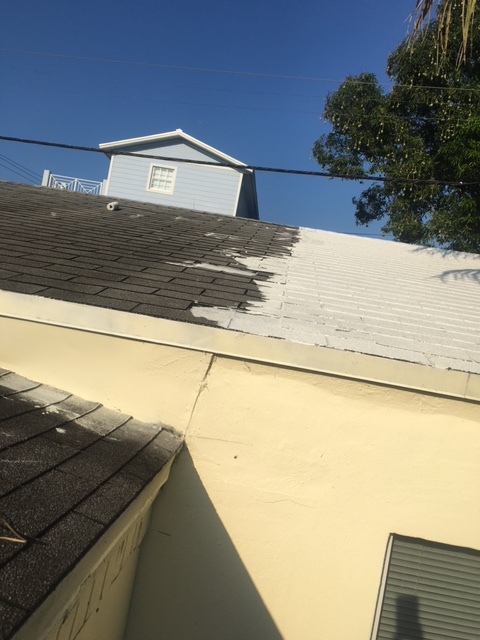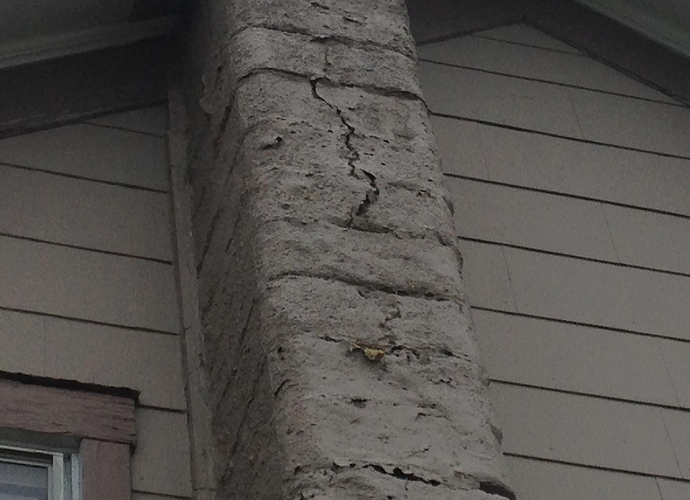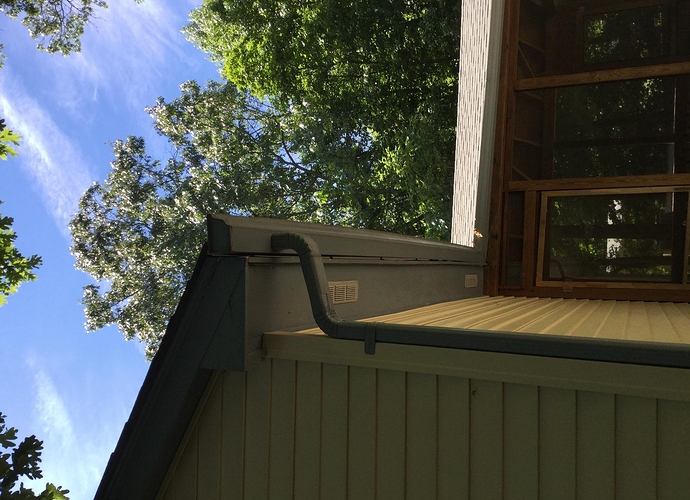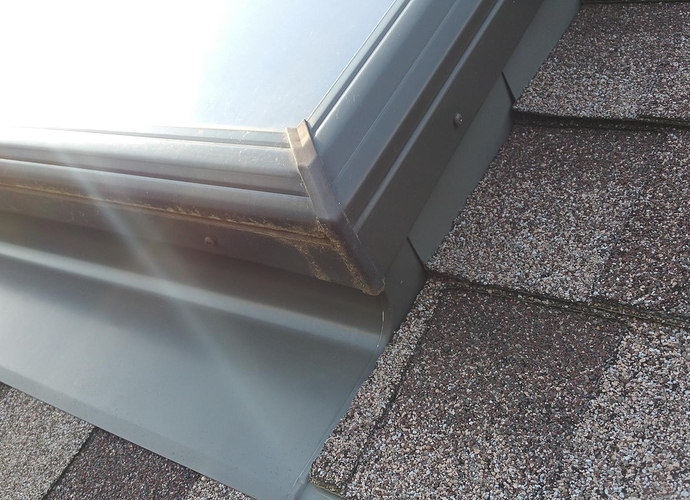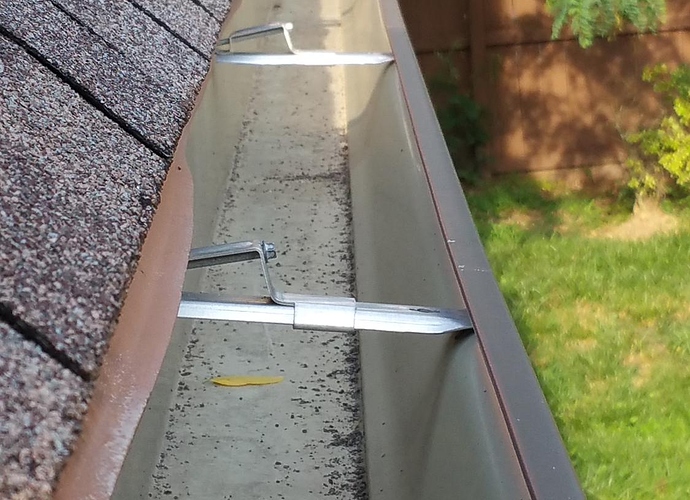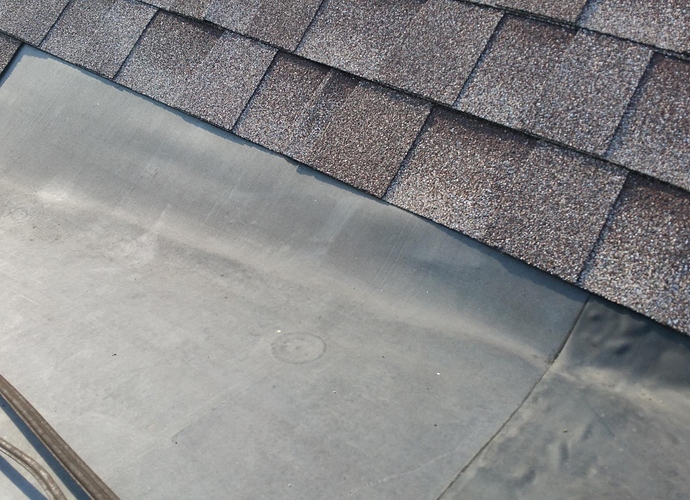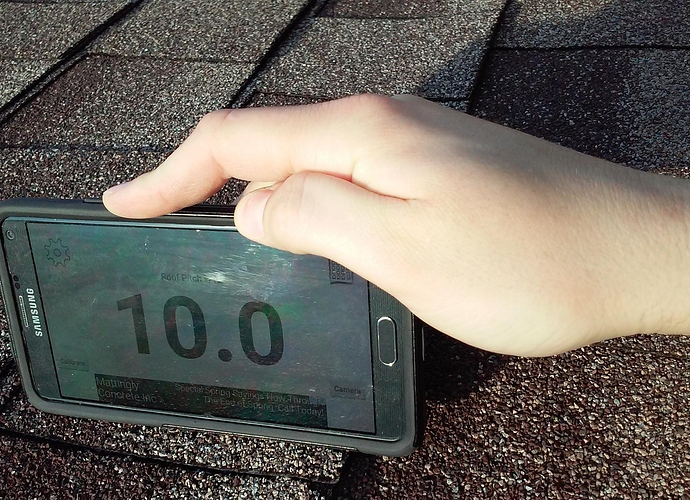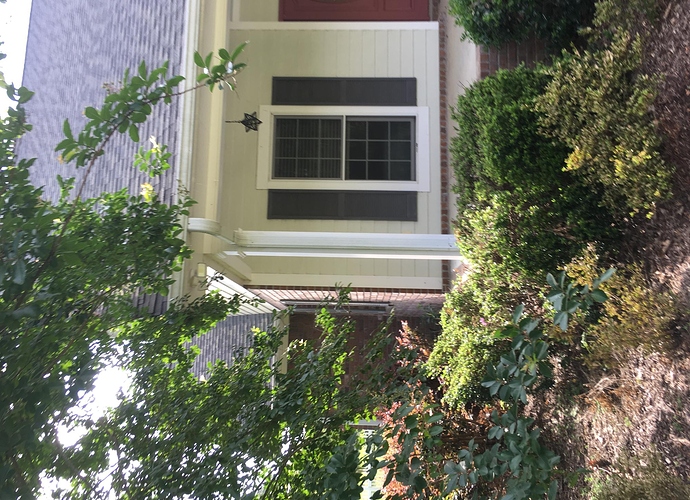I chose to do directional hail damage since I live in the Windy City of Cheyenne, Wyoming and we have a lot of hail storms and wind damage. I have learned that the hail damage would be generally on just one side of a roof because the opposing side would just deflect the impact. It will also be an impression and not like a blister.
This is a three tab asphalt roof covering placed over an older asphalt roofing material. Although there are only 2 layers I would still note it, including the extra weight load, and do a more extensive inspection of the attic to insure the new roof was fastened correctly. I would be looking particularly for roofing nails to have penetrated the new roof covering, the older roof and the sheathing as well as the flashing to make sure it was installed properly with the new roof covering. The new roofing material appears to be in good shape with most of the granules still attached.
Cheers,
Kevin Johnson
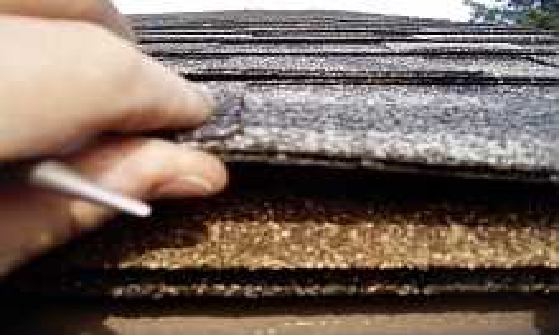
Since the course I am presently on is roofing I decided to do my research project on a similar topic. I choose “Chimney Inspection: Preventing Collapse”, a worthy topic as I am sure no one wants to have their chimney fall down on them.
Although earthquake damage is unlikely in my current state of Florida (I did live in the pacific NW for many years and have been through several earth shaking events) we do have the potential for hurricane damage. I would be inspecting the mortar joints for any disintegration, looking for any mechanical damage from trees or other debris, and reviewing to insure the proper footings were set.
For the most part, the roof covering on this home was in fine shape. However there was damage to the shingles on one corner of the building and there’s debris in the area. To prevent water intrusion the shingles should be repaired or replaced.
This is an architectural asphalt shingle roof in new condition. The shingles are in good condition with no visible signs of wear or damage. Step flashing is present under the shingle layer and counter flashing is installed. Kick out flashing is missing at the termination of the roof/wall intersection. This is allowing water to pass behind installed gutter system and down face of wall. Note the visible water stain present under gutter.
Research: Ceiling Fans
The Good news is ceiling fans will not decapitate you - but it can hurt your head or cut your neck. Common defects found in ceiling fans include falling, wobbling, and inadequate clearance above the floor.
These fans should never be used outdoors and require a minimum of 7ft clearance above the floor.
Fans should operate in the correct direction for the season, and work best when they are 8-9 ft above the floor.
This is an image of a flat roof with concrete tiles wrapped around the outsides of it. As you can see some of the tiles along the upper edge have come loose and fallen off. The roll roofing at the edges where the tiles are missing has lifted and may allow water / moisture intrusion. Large areas of the flat roof also had areas of blistering / bubbling. This roof definitely needs further evaluation by a licensed roofing contractor!
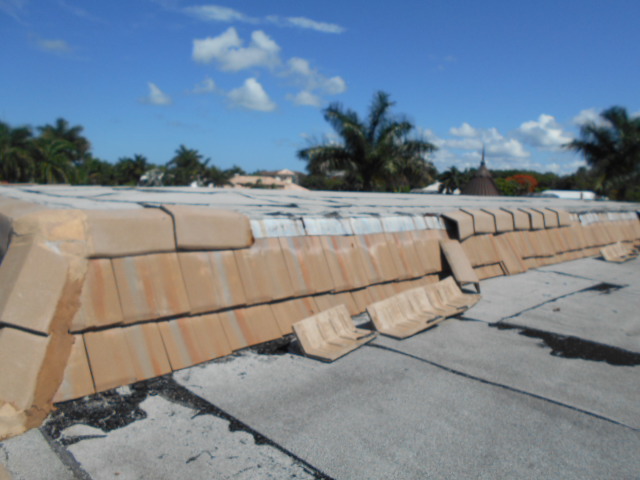
Research: Kickout flashing
Although Kickout flashing is a recent development in building practices the it’s importance can not be understated. Kickout flashing is installed at the end of a roof/wall intersection and diverts water away from the building envelope and into the gutter. Due to the increased tightness of modern construction a lack of Kickout flashing can lead to more moisture problems than ever if water is allowed to penetrate the wall. Kickout flashing problems happen for a variety of reasons. Failure to install, modification by homeowners, and improper installation by installers. All of these should be looked for during a home inspection. Even though Kickout flashing is a small part of the overall roof structure a failure of this component can cause tremendous damage.
After studying the “How to Perform Roof Inspections” material, I was reminded of certain facts about the types and necessity of flashing.I also gained some new knowledge of just how important it is to the roof and home. Improper / missing flashing can lead to costly repairs. This information will help sharpen my inspection skills and help me to perform a more thorough overall roof inspection.
After having performed over 500 full home inspection to date, some patterns emerge. For example, the plumbing vent boots (the neoprene collar which connects the roof flashing to the plumbing vent stack) typically last from 10-15 years in this environment (Willamette valley in Oregon, “Rain capital of the west coast”).
While typical architectural shingles have a 30 year rating (though seldom achieving this).
It stands to reason that these vent boots should be replaced 1 to 2 times during the life of this type of roof covering. The pattern I see is this: A small stain on the ceiling of a bathroom or kitchen appears. The homeowner decides they will save some money and fix this themselves. They buy roofing tar from the local HD and proceed to cover the vent and roofing materials in one foot wide perimeter, hoping to somehow stop the leak. However, the one area they don’t cover is the cracked vent boot, from whence the leak cometh!
If by chance the cracked boot is covered with tar, this repair typically lasts about one season before the tar cracks, the leak reappears and the cycle of life continues…
My advice to all my clients is to hire a licensed and bonded roofing contractor to replace the entire vent boot (along with all his dried up and ready to crack brethren) and then forget about them for the next 10-15 years.
Research on roofing penetrations:
I have found that roof penetrations are the weak points of the roof system and that most repairs performed on these areas are lacking the expertise and understanding of what actually works.
Flashings are typically designed to work without the aid of roofing tar or sealant, but time and time again, the first attempt at sealing leaks at the penetrations is to apply roof tar in copious amounts and in ever-widening swaths in hopes of somehow stopping the leak.
I am humbled to say this is how I’ve attempted to solve roof leaks on my own home in the past. But armed with new knowledge and my increasing conviction that licensed professionals are the best route to fixing these problems, I’ve hired a mason to spend whatever time it takes this summer repairing all the chimney flashing, lining, crown and other issues on my 1928 home.
I was feeling quite bad siting these same issues on other poor homeowners while knowing I was following the same well trodden pathway to mediocre home repairs. (I was a journeyman finish carpenter, but being in the trades, I’m supposed to know how to do everything, right?)
My wife is now happy that this work will finally get done and that I will no longer be such a hypocrite, at least in this area!
See the attached photo of a standard 3-tab roof. The roof is very weathered and the granules are missing in locations. The photo shows where a section of roof has been patched and a paint roller from the repair work is shown. I suggest a consultation with a licensed roofing contractor.
During my research I studied the importance of a properly flashed roof penetrations. Improperly flashed roof penetrations are one of the most common causes of a failing roof. This is extremely important to carefully inspect all roof penetrations during an inspection because the penetration is through the roof, underlayment and waterproofing membrane directly into the home. Buckling of shingles around the perimeter is a clear sign of water intrusion at a roof penetration.
Hello,
I’m writing about a chimney defect that I found during an inspection. In the photo you can see failing stucco and chimney separation from the house. Also, I found water stains in the attic around the chimney indicating past water stains. I wrote out the report that due to a stucco covering that I could not determine or see the chimney’s condition and I recommended this to be evaluated by a licensed contractor.
Thanks,
Bill
Hello,
I’m writing about roof drainage systems. While reading this article, I’ve been reminded how critical it is for a roof to shed water properly. while rain gutters are the best solution to homes, flashing is of the same importance. When all drain systems are working properly, structures can stay relatively water resistant for many years.
Thanks,
Bill
In this photo of the gutter system it shows several sections of the gutter are not secured to the home properly. This can cause inadequate drainage which could result in water damage to the wood trim of the home. I recommend having the entire gutter system repaired or replaced by a certified professional gutter repair person.
I decided to look at my own roof. Overall my roof looks pretty good. When we purchased the home, the seller’s disclosure stated that the roof had been installed in 2008. The roof has a slope of 10:12.
We have 3-tab asphalt shingles for the majority of the roof. I did however notice that for one portion, connecting the home to the garage, we have membrane roofing installed. It slopes downward and I found no evidence of ponding. Both roofing materials seem to be in good working order.
The gutters were clean. There was a light amount of asphalt shingle aggregate in the gutter. One of the gutter spikes is backed out.
Another issue I noticed was missing flashing around the fireplace. The wood around the base of the fireplace is falling apart.
Research assignment:
I read the article on “cool” roofing. I found this very interesting, as I have never heard of them before. The article states that it can reduce peak cooling demands up to 15%. That number is significant. It also stated that some utilities will pay you a rebate if you have the roof installed. I work at our local utility and checked into our rebate programs. We do not offer any rebates for “cool” roofing materials. After reading this article I am interested in learning more about these systems. It might be something I suggest to our energy efficiency team at work.
From what the article said these systems can be used over many different types of existing roofing materials or as a new installation. What this system does is it reflects the sun’s radiant energy back into space instead of transferring it into the structure. I wonder how long these systems typically last and how damage resistant they are?
The article I read was on the difference is Collar Ties vs. Rafter ties. Both are a critical part of the roof structure but play different parts. A Collar tie is in the upper third of opposing gable rafters & designed to resist rafter separation unbalanced loads like snow. Rafter ties are in the bottom third of opposing gables & designed to resist outword thrust in a rafter. This was an imforative article that explains a critical part of the roof system.
Roofing
The roof style is side gabled with a pitch of 10/12.
Viewed from the ground level due to the pitch of roof.
Venting: ridge venting, gabled venting, soffit venting
Roof covering is of fiberglass-based asphalt shingles…
Age of roof is 8 years of same age of house.
In general the roof, flashing is not visible for inspection.
There is 1 section where tree branches are against the roof.
PVC vent stacks visibility seen right.
There is no chimney on this house.
Roof drainage aluminum gutters and down spouts discharging water away from foundations.
[ATTACH]140582/ATTACH
